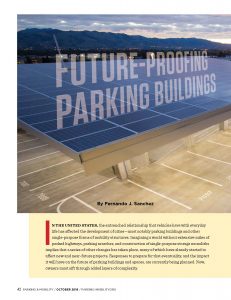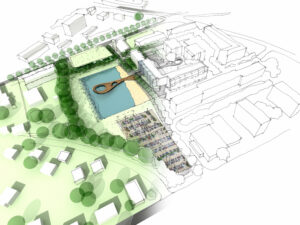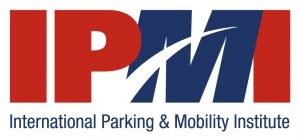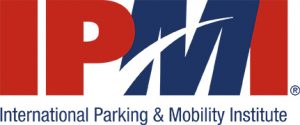By Fernando Sanchez
IN THE UNITED STATES, the entrenched relationship that vehicles have with everyday life  has affected the development of cities—most notably parking buildings and other single-purpose forms of mobility structures. Imagining a world without extensive miles of packed highways, parking searches, and construction of single-purpose storage monoliths implies that a series of other changes has taken place, many of which have already started to affect new and near-future projects. Responses to prepare for that eventuality, and the impact it will have on the future of parking buildings and spaces, are currently being planned. Now, owners must sift through added layers of complexity.
has affected the development of cities—most notably parking buildings and other single-purpose forms of mobility structures. Imagining a world without extensive miles of packed highways, parking searches, and construction of single-purpose storage monoliths implies that a series of other changes has taken place, many of which have already started to affect new and near-future projects. Responses to prepare for that eventuality, and the impact it will have on the future of parking buildings and spaces, are currently being planned. Now, owners must sift through added layers of complexity.
The paths available to future-proof a parking building involve choosing how and when to incorporate various responses to a development. As adherence to newly enacted codes and regulations, global and regional climate change goals, and construction practices continue to emerge, the supply of parking for projects becomes a complicated decision that affects overall cost and design.
Making sense of what solutions should be included in a development remains a multi-faceted discussion as cost, timeframes, and available design choices all weigh on a project. Guides and certification programs exist to determine prescribed levels of green and sustainable features, amenities, and conditions. The U.S. Green Building Council’s LEED program and, specifically for parking facilities, Parksmart, are some of the most widely known guides and references used in the U.S. However, without clear means to evaluate features and concepts described in these guides, a myriad of project priorities, goals, and opportunities can be overlooked or not explored at all.
Target Value Delivery
Every worthy parking designer and/or builder will have a repertoire of explored, studied, and constructed solutions that can be implemented. Options range from easily implemented program requirements to wholesale plans that convert from parking to other non-storage use. But solutions are not one-size-fits-all, and what is appropriate for a hospital campus may not make sense for a high-density mixed-used development.
Equally differentiating are cost implications. Some responses can easily be incorporated with minimal cost, but there are those that can increase project costs many-fold—sometimes beyond 50 percent of typical expenses for self-parking projects. More appropriate to cost evaluations are the non-design components, such as financing, ownership portfolios, and other similar issues.
A system that aids in response selection and provides cost and schedule certainty helps organize a project to appropriately evaluate future-proofing options. The target value delivery method implements a series of tools and approaches to define the owner’s program requirements (OPR), which then is extrapolated to define the conditions of satisfaction (CoS) that guide a basis of design (BOD) document for the project. This system sets the framework for owners to achieve success with their projects.
Depending on the delivery method selected by the owner—traditional design-bid-build, design-build, or any of a series on the spectrum—the output helps guide owners to make appropriate selections for their project. Whether created with a designer or by a design-build team, the OPR establishes the initial overarching direction and goals the project needs to achieve. Is it desired to reach LEED platinum levels, or will Parksmart certification be required? What is the desired interaction between the street and the building? Does the project need to respond to future changes in five, 10, or 15 years? Whichever direction chosen, an owner’s first step is to define desired aspirations and goals specific to desired outcomes, not “what it looks like,” but rather “what it should accomplish.”
FUTURE-PROOFING ALTERNATIVES
Now, with an understanding of how to evaluate available alternatives,
consider the following list and categorization of possible alternatives on a parking development:
Alternatives to define at the OPR stage:
1. Transportation-oriented Development.
• Connectivity to mass transit hubs.
• Last-mile traveled support systems.
2.Street/curb management.
3.Changes in use; parking is vehicle-oriented.
•Change to human-oriented uses.
•Change to other non-human–oriented use.
4.Sustainability goals.
5.Reduction of energy use.
6.Energy generation/storage onsite.
7.Improved mobility responses.
Definition of alternatives at the COS stage:
1.Transportation.
•Degree to build connectivity to the street.
2.Street management.
•Self-driving vehicles.
•Improvement of use of curb.
3.Change in use.
•Battery farms.
•Network nodes.
•Autonomous vehicle infrastructure.
•Automatic vehicle storage and retrieval systems.
4.Sustainability goals.
•Materials used in construction.
•Quantity of electric-vehicle (EV) charging stations.
5.Reduce energy use.
•Lighting systems.
•Construction methods and embodied energy.
6.Generate energy onsite.
•Dynamos/generators.
•Steam.
•Wind.
•Hydroelectric.
•Photovoltaic arrays.
7.Mobility improvements.
•Ride-share.
•Scooters.
Application of alternatives at the BOD stage:
1.Transportation—parking and EV station locations—participation in mapping apps.
2.Type of connectivity.
•Bus stop proximity.
•Dedicated lanes for various transportation modes.
•Allocation of space at development.
•Management programs for transportation—incentives, discount programs, emergency transportation.
3.Implications of feature to add in converting use.
•Higher ceilings.
•Sloped floors.
•Egress requirements.
•Fire life safety requirements.
•Mechanical lifts—user operated.
•Semi-automatic—puzzle systems that are user operated with some logic board.
•Full-automatic—full computer operated at input bays; City of West Hollywood, Calif., for example.
4.Materials used in construction.
•Carbon curing—capturing CO2 from industrial emitters into concrete mix—converts to CaCO3 (calcium carbonate—capturing CO2).
•Type of charging stations, such as ChargePoint vs. Tesla chargers.
•Code minimums (8 percent EV spaces in California) or higher voluntary tiers.
5.Reduction of energy use.
•Light fixture performance.
•Lighting strategies—daylight harvesting.
6.Power generation onsite.
•Extent of power generation—in kWH or surface area available.
7.Mobility improvements.
•Service requirements—areas to host shared-ride services.
Further into the project’s development, the owner’s next step is to define the CoS—a detailed description of how a design response will be measured to achieve the OPR. Perfect examples are the LEED and Parksmart point system certification levels. The CoS should tailor the point categories of each rating system and describe a means to determine any priorities in design responses. The categories created in the Parksmart guide serve well in evaluating a parking projects attainment of the OPR by categorizing the myriad design responses to future proofing: management, programs, technology and structure design, and innovation. Similarly, the CoS could indicate the expected LEED level to be achieved—silver, gold, platinum. For projects in California, describing which higher voluntary tier requirements listed in CalGreen are important to satisfying the OPR.
The third and final step in determining how to futureproof a parking development is diving into the myriad responses with the design team and, whenever possible, the construction team, to develop the project’s BOD. The inclusion of the construction team is to analyze constructability and schedule effects. Typically, this evaluation takes place during early design phases. The BOD should identify the specific nature of each response or component and how it will achieve the levels set in the CoS. A properly developed BOD should align with the development of the project’s performance specifications. Specific considerations to include are the components and modifications important to each system in case replacements are required in the future. A naturally ventilated parking building will not include a mechanical ventilation system, but if the project is determined to need exhaust and supply fans in the future, the size and volume consideration should be clearly identified.
Choosing by Advantages
The crux in creating a BOD lies with determining which systems to include and to what degree they need to be defined to meet the CoS. It is quite easy to say that cost exceeds all other considerations, but in transforming into a more sustainable world, opportunity costs can be offset by other features that achieve OPR. With that in mind, the LEAN Institute and others have written extensively on ways that Choosing by Advantages (CBA)—a decision-making method to determine best decisions by weighting advantages of particular options for consideration and selection—can be implemented and the steps involved to achieve selection.
Applied to future-proofing a parking development (or any development for that matter), CBA provides a system to study various options based on valuing the importance of advantages between a particular set of options described in the CoS and determine the best choice. Familiar to many in the AEC (architecture, engineering, and construction) world is the use of the Tabular Method to record this evaluation, and many great summary explanations have been published detailing the step-by-step procedures.
Criteria to be evaluated will be particular to each system. For example, if the program requirements identify future conversion for revenue gain, the CoS could identify a future conversion from a self-park system to a mechanical parking system. To determine which mechanical parking system to define in the BOD, CBA could compare the self-parking design to a parking-lift system, puzzle-lift system, and a full-automatic system. Factors to evaluate would identify the extent of changes required for conversion, structural system initial requirements, fire life safety system initial requirements, fire life safety future requirements, revenue potential, aesthetics, serviceability, and area-per-parking space, among other things. The attributes of each alternative would then be summarized, and the advantage of each would be determined from the least preferred attribute of each factor and ultimately charting the advantages of each alternative against the cost of each system to determine the best solution to incorporate. The last step uses cost to determine a comparison chart for selection.
CBA allows for a transparent and open evaluation of various systems to consider when deciding to future-proof a parking building.
To borrow from Nils Bohr, Nobel laureate, “Prediction is very difficult, especially if it’s about the future.” It may be a daunting task to future-proof a development based on the many alternatives and systems currently or possibly available in the offing. However, using the described system to evaluate, compare, and select from the various alternatives will help a project team select the most appropriate alternatives for a given parking building project.
Read the article here.
FERNANDO J. SANCHEZ is an integrated design director with McCarthy Building Companies, Inc. He can be reached at fsanchez@mccarthy.com.
 Traditional cities are typically found on and around transport routes–rivers, roads and railways. They occupy strategic locations for trade, security, crossings, and meeting points. Streets/roads define the city/urban form as both paths and edges. In the past few centuries, attempts to fix the city have focused on the restructuring of the road and transport systems. New transport technologies have been central to the rethinking and reshaping of the city; that has been the case in the past and will very likely be the case in the future.
Traditional cities are typically found on and around transport routes–rivers, roads and railways. They occupy strategic locations for trade, security, crossings, and meeting points. Streets/roads define the city/urban form as both paths and edges. In the past few centuries, attempts to fix the city have focused on the restructuring of the road and transport systems. New transport technologies have been central to the rethinking and reshaping of the city; that has been the case in the past and will very likely be the case in the future.


 By Marlene Cramer, CAPP
By Marlene Cramer, CAPP





 By Brett Wood, CAPP
By Brett Wood, CAPP